Responses of N2O, CO2, and NH3 Emissions to Biochar and Nitrification Inhibitors Under a Delayed Nitrogen Application Regime
Abstract
1. Introduction
2. Materials and Methods
2.1. Experimental Region
2.2. Experimental Design
2.3. Gas Emissions Measurement
2.4. Soil Collection and Analysis
2.5. Enzyme Activity Associated with Soil N Cycling
2.6. Statistical Analyses
3. Results
3.1. Effects of N Fertilizer, Biochar, and DMPP on Soil Characteristics
3.2. Temporal Variation in External and Soil Environment Indicators
3.3. N2O and CO2 Emissions
3.4. NH3 Volatilization
3.5. Enzyme Activities Associated with Soil N Cycling
3.6. Grain Yield and NUE
3.7. Principal Component Analysis and Random Forest Algorithm
4. Discussion
4.1. Impact of Biochar on N2O and NH3 Emissions
4.2. Responses of N2O, CO2, and NH3 Emissions to DMPP and Biochar
4.3. Responses of Soil Indexes and Crop Productivity to Biochar and DMPP
5. Conclusions
Supplementary Materials
Author Contributions
Funding
Data Availability Statement
Conflicts of Interest
References
- Stevens, C.J. Nitrogen in the environment. Science 2019, 363, 578–580. [Google Scholar] [CrossRef] [PubMed]
- Tian, H.; Xu, R.; Canadell, J.G.; Thompson, R.L.; Winiwarter, W.; Suntharalingam, P.; Davidson, E.A.; Ciais, P.; Jackson, R.B.; Janssens-Maenhout, G.; et al. A comprehensive quantification of global nitrous oxide sources and sinks. Nature 2020, 586, 248–256. [Google Scholar] [CrossRef]
- Bahram, M.; Espenberg, M.; Pärn, J.; Lehtovirta-Morley, L.; Anslan, S.; Kasak, K.; Koljalg, U.; Liira, J.; Maddison, M.; Moora, M.; et al. Structure and function of the soil microbiome underlying N2O emissions from global wetlands. Nat. Commun. 2022, 13, 1430. [Google Scholar] [CrossRef] [PubMed]
- Shakoor, A.; Shakoor, S.; Rehman, A.; Ashraf, F.; Abdullah, M.; Shahzad, S.M.; Farooq, T.H.; Ashraf, M.; Manzoor, M.A.; Altaf, M.M.; et al. Effect of animal manure, crop type, climate zone, and soil attributes on greenhouse gas emissions from agricultural soils—A global meta-analysis. J. Clean. Prod. 2021, 278, 124019. [Google Scholar] [CrossRef]
- Hong, C.; Burney, J.A.; Pongratz, J.; Nabel, J.E.; Mueller, N.D.; Jackson, R.B.; Davis, S.J. Global and regional drivers of land-use emissions in 1961–2017. Nature 2021, 589, 554–561. [Google Scholar] [CrossRef]
- Mikhael, J.E.R.; Wang, J.J.; Dodla, S.; Scaglia, G.; Dattamudi, S. Effects of biochar and N-stabilizers on greenhouse gas emissions from a subtropical pasture field applied with organic and inorganic nitrogen fertilizers. J. Environ. Manag. 2022, 306, 114423. [Google Scholar] [CrossRef]
- Cui, H.; Zhu, H.; Zhang, F.M.; Wang, X.Y.; Hou, S.N.; Feng, W.D. Soil amendments reduce CH4 and CO2 but increase N2O and NH3 emissions in saline-alkali paddy fields. Sci. Total Environ. 2024, 924, 171673. [Google Scholar] [CrossRef]
- Yang, S.L.; Wang, M.Y.; Wang, W.J.; Zhang, X.C.; Han, Q.; Wang, H.F.; Xiong, Q.Q.; Zhang, C.H.; Wang, M.S. Establishing an emission inventory for ammonia, a key driver of haze formation in the southern North China plain during the COVID-19 pandemic. Sci. Total Environ. 2023, 904, 166857. [Google Scholar] [CrossRef]
- Ma, R.; Zou, J.; Han, Z.; Yu, K.; Wu, S.; Li, Z.; Liu, S.; Niu, S.; Horwath, W.R.; Zhu-Barker, X. Global soil-derived ammonia emissions from agricultural nitrogen fertilizer application: A refinement based on regional and crop-specific emission factors. Glob. Chang. Biol. 2021, 27, 855–867. [Google Scholar] [CrossRef]
- Chen, D.Y.; Liu, H.; Ning, Y.W.; Xu, C.; Zhang, H.; Lu, X.Y.; Wang, J.D.; Xu, X.J.; Feng, Y.Y.; Zhang, Y.C. Reduced nitrogen fertilization under flooded conditions cut down soil N2O and CO2 efflux: An incubation experiment. J. Environ. Manag. 2022, 324, 116335. [Google Scholar] [CrossRef]
- Sui, B.; Feng, X.; Tian, G.; Hu, X.; Shen, Q.; Guo, S. Optimizing nitrogen supply increases rice yield and nitrogen use efficiency by regulating yield formation factors. Field Crop. Res. 2013, 150, 99–107. [Google Scholar] [CrossRef]
- Wang, G.; Luo, Z.; Wang, E.; Zhang, W. Reducing greenhouse gas emissions while maintaining yield in the croplands of Huang-Huai-Hai Plain, China. Agric. For. Meteorol. 2018, 260, 80–94. [Google Scholar] [CrossRef]
- Duan, J.Z.; Shao, Y.H.; He, L.; Li, X.; Hou, G.G.; Li, S.N.; Feng, W.; Zhu, Y.J.; Wang, Y.H.; Xie, Y.X. Optimizing nitrogen management to achieve high yield, high nitrogen efficiency and low nitrogen emission in winter wheat. Sci. Total Environ. 2019, 697, 134088. [Google Scholar] [CrossRef] [PubMed]
- Li, W.; Xie, H.; Ren, Z.; Li, T.; Wen, X.; Han, J.; Liao, Y. Response of N2O emissions to N fertilizer reduction combined with biochar application in a rain-fed winter wheat ecosystem. Agric. Ecosyst. Environ. 2022, 333, 107968. [Google Scholar] [CrossRef]
- Guardia, G.; Sanz-Cobena, A.; Sanchez-Martín, L.; Fuertes-Mendizábal, T.; González-Murua, C.; Álvarez, J.M.; Chadwick, D.; Vallejo, A. Urea-based fertilization strategies to reduce yield-scaled N oxides and enhance bread-making quality in a rainfed Mediterranean wheat crop. Agric. Ecosyst. Environ. 2018, 265, 421–431. [Google Scholar] [CrossRef]
- Li, Z.; Xu, P.; Han, Z.; Wu, J.; Bo, X.; Wang, J.; Zou, J. Effect of biochar and DMPP application alone or in combination on nitrous oxide emissions differed by soil types. Biol. Fertil. Soils. 2023, 59, 123–138. [Google Scholar] [CrossRef]
- Cassman, N.A.; Soares, J.R.; Pijl, A.; Lourenço, K.S.; van Veen, J.A.; Cantarella, H.; Kuramae, E.E. Nitrification inhibitors effectively target N2O-producing Nitrosospira spp. in tropical soil. Environ. Microbiol. 2019, 21, 1241–1254. [Google Scholar] [CrossRef] [PubMed]
- Zhou, X.; Wang, S.; Ma, S.; Zheng, X.; Wang, Z.; Lu, C. Effects of commonly used nitrification inhibitors—Dicyandiamide (DCD), 3,4-dimethylpyrazole phosphate (DMPP), and nitrapyrin—On soil nitrogen dynamics and nitrifiers in three typical paddy soils. Geoderma 2020, 380, 114637. [Google Scholar] [CrossRef]
- Wu, D.; Zhang, Y.X.; Dong, G.; Du, Z.L.; Wu, W.L.; Chadwick, D.; Bol, R. The importance of ammonia volatilization in estimating the efficacy of nitrification inhibitors to reduce N2O emissions: A global meta-analysis. Environ. Pollut. 2021, 271, 116365. [Google Scholar] [CrossRef]
- Tufail, M.A.; Irfan, M.; Umar, W.; Wakeel, A.; Schmitz, R.A. Mediation of gaseous emissions and improving plant productivity by DCD and DMPP nitrification inhibitors: Meta-analysis of last three decades. Environ. Sci. Pollut. Res. 2023, 30, 64719–64735. [Google Scholar] [CrossRef]
- Li, S.; Sha, Z.; Zhang, X.; Lv, J.; Chen, X.; Yang, Q. Fertilizers inclusion with nitrification inhibitors alleviate soil CO2 emissions: A meta-analysis study. J. Soil. Sediment. 2023, 23, 2011–2020. [Google Scholar] [CrossRef]
- Menéndez, S.; Barrena, I.; Setien, I.; González-Murua, C.; Estavillo, J.M. Efficiency of nitrification inhibitor DMPP to reduce nitrous oxide emissions under different temperature and moisture conditions. Soil. Biol. Biochem. 2012, 53, 82–89. [Google Scholar] [CrossRef]
- Wang, D.; Fonte, S.J.; Parikh, S.J.; Six, J.; Scow, K.M. Biochar additions can enhance soil structure and the physical stabilization of C in aggregates. Geoderma 2017, 303, 110–117. [Google Scholar] [CrossRef] [PubMed]
- Taghizadeh-Toosi, A.; Clough, T.J.; Condron, L.M.; Sherlock, R.R.; Anderson, C.R.; Craigie, R.A. Biochar incorporation into pasture soil suppresses in situ nitrous oxide emissions from ruminant urine patches. J. Environ. Qual. 2011, 40, 468–476. [Google Scholar] [CrossRef]
- Sun, H.J.; Lu, H.Y.; Chu, L.; Shao, H.B.; Shi, W.M. Biochar applied with appropriate rates can reduce N leaching, keep N retention and not increase NH3 volatilization in a coastal saline soil. Sci. Total Environ. 2017, 575, 820–825. [Google Scholar] [CrossRef]
- He, T.; Yuan, J.; Xiang, J.; Lin, Y.; Luo, J.; Lindsey, S.; Liao, X.; Liu, D.; Ding, W. Combined biochar and double inhibitor application offsets NH3 and N2O emissions and mitigates N leaching in paddy fields. Environ. Pollut. 2022, 292, 118344. [Google Scholar] [CrossRef]
- Huang, M.; Wang, C.; Qi, W.; Zhang, Z.; Xu, H. Modelling the integrated strategies of deficit irrigation, nitrogen fertilization, and biochar addition for winter wheat by AquaCrop based on a two-year field study. Field Crops Res. 2022, 282, 108510. [Google Scholar] [CrossRef]
- Chintala, R.; Schumacher, T.E.; Kumar, S.; Malo, D.D.; Rice, J.A.; Bleakley, B.; Chilom, G.; Clay, D.E.; Julson, J.L.; Papiernik, S.K.; et al. Molecular characterization of biochars and their influence on microbiological properties of soil. J. Hazard. Mater. 2014, 279, 244–256. [Google Scholar] [CrossRef]
- Wang, J.; Pan, X.; Liu, Y.; Zhang, X.; Xiong, Z. Effects of biochar amendment in two soils on greenhouse gas emissions and crop production. Plant Soil 2012, 360, 287–298. [Google Scholar] [CrossRef]
- Wu, Z.; Zhang, Q.; Zhang, X.; Duan, P.; Yan, X.; Xiong, Z. Biochar-enriched soil mitigated N2O and NO emissions similarly as fresh biochar for wheat production. Sci. Total Environ. 2020, 701, 134943. [Google Scholar] [CrossRef]
- De Santis, M.A.; Giuliani, M.M.; Flagella, Z.; Reyneri, A.; Blandino, M. Impact of nitrogen fertilisation strategies on the protein content, gluten composition and rheological properties of wheat for biscuit production. Field Crop. Res. 2020, 254, 107829. [Google Scholar] [CrossRef]
- Malhi, S.S.; Grant, C.A.; Johnston, A.M.; Gill, K.S. Nitrogen fertilization management for no-till cereal production in the Canadian Great Plains: A review. Soil Tillage Res. 2001, 60, 101–122. [Google Scholar] [CrossRef]
- Thilakarathna, S.K.; Hernandez-Ramirez, G.; Puurveen, D.; Kryzanowski, L.; Lohstraeter, G.; Powers, L.A.; Quan, N.; Tenuta, M. Nitrous oxide emissions and nitrogen use efficiency in wheat: Nitrogen fertilization timing and formulation, soil nitrogen, and weather effects. Soil Sci. Soc. Am. J. 2020, 84, 1910–1927. [Google Scholar] [CrossRef]
- Ravier, C.; Meynard, J.M.; Cohan, J.P.; Gate, P.; Jeuffroy, M.H. Early nitrogen deficiencies favor high yield, grain protein content and N use efficiency in wheat. Eur. J. Agron. 2017, 89, 16–24. [Google Scholar] [CrossRef]
- He, T.; Liu, D.; Yuan, J.; Luo, J.; Lindsey, S.; Bolan, N.; Ding, W. Effects of application of inhibitors and biochar to fertilizer on gaseous nitrogen emissions from an intensively managed wheat field. Sci. Total Environ. 2018, 628, 121–130. [Google Scholar] [CrossRef]
- Sun, G.L.; Zhang, Z.G.; Xiong, S.W.; Guo, X.Y.; Han, Y.C.; Wang, G.P.; Feng, L.; Lei, Y.P.; Li, X.F.; Yang, B.F.; et al. Mitigating greenhouse gas emissions and ammonia volatilization from cotton fields by integrating cover crops with reduced use of nitrogen fertilizer. Agric. Environ. Res. 2022, 332, 107946. [Google Scholar] [CrossRef]
- Lu, R.K. Soil Agricultural Chemistry Analysis; Chinese Agriculture and Technology Press: Beijing, China, 2000; pp. 13–14+108–109+147–149+168–169+181+194–195. (In Chinese) [Google Scholar]
- Liao, X.; Niu, Y.; Liu, D.; Chen, Z.; He, T.; Luo, J.; Lindsey, S.; Ding, W. Four-year continuous residual effects of biochar application to a sandy loam soil on crop yield and N2O and NO emissions under maize-wheat rotation. Agric. Ecosyst. Environ. 2020, 302, 107109. [Google Scholar] [CrossRef]
- Agegnehu, G.; Bass, A.M.; Nelson, P.N.; Bird, M.I. Benefits of biochar, compost and biochare compost for soil quality, maize yield and greenhouse gas emissions in a tropical agricultural soil. Sci. Total Environ. 2016, 543, 295–306. [Google Scholar] [CrossRef]
- Cayuela, M.L.; Jeffery, S.; van Zwieten, L. The molar H: Corg ratio of biochar is a key factor in mitigating N2O emissions from soil. Agric. Ecosyst. Environ. 2015, 202, 135–138. [Google Scholar] [CrossRef]
- Liu, Q.; Wu, Y.; Ma, J.; Jiang, J.; You, X.; Lv, R.; Zhou, S.; Pan, C.; Liu, B.; Xu, Q.; et al. How does biochar influence soil nitrification and nitrification-induced N2O emissions? Sci. Total Environ. 2024, 908, 168530. [Google Scholar] [CrossRef]
- Troy, S.M.; Lawlor, P.G.; O’Flynn, C.J.; Healy, M.G. Impact of biochar addition to soil on greenhouse gas emissions following pig manure application. Soil Biol. Biochem. 2013, 60, 173–181. [Google Scholar] [CrossRef]
- Maljanen, M.; Liikanen, A.; Silvola, J.; Martikainen, P.J. Nitrous oxide emissions from boreal organic soil under different land-use. Soil Biol. Biochem. 2003, 35, 689–700. [Google Scholar] [CrossRef]
- Sun, H.W.; Jiang, T.T.; Zhang, F.; Zhang, P.; Zhang, H.; Yang, H.; Lu, J.B.; Ge, S.J.; Ma, B.; Ding, J.; et al. Understanding the effect of free ammonia on microbial nitrification mechanisms in suspended activated sludge bioreactors. Environ. Res. 2021, 200, 111737. [Google Scholar] [CrossRef]
- Feng, Z.; Zhu, L. Impact of biochar on soil N2O emissions under different biochar-carbon/fertilizer-nitrogen ratios at a constant moisture condition on a silt loam soil. Sci. Total Environ. 2017, 584, 776–782. [Google Scholar] [CrossRef]
- Liu, J.; Shen, J.; Li, Y.; Su, Y.; Ge, T.; Jones, D.L.; Wu, J. Effects of biochar amendment on the net greenhouse gas emission and greenhouse gas intensity in a Chinese double rice cropping system. Eur. J. Soil Biol. 2014, 65, 30–39. [Google Scholar] [CrossRef]
- Liu, H.; Li, H.; Zhang, A.; Rahaman, M.A.; Yang, Z. Inhibited effect of biochar application on N2O emissions is amount and time-dependent by regulating denitrification in a wheat-maize rotation system in North China. Sci. Total Environ. 2020, 721, 137636. [Google Scholar] [CrossRef]
- Lin, Y.X.; Ding, W.X.; Liu, D.Y.; He, T.H.; Yoo, G.; Yuan, J.J.; Chen, Z.M.; Fan, J.L. Wheat straw-derived biochar amendment stimulated N2O emissions from rice paddy soils by regulating the amoA genes of ammonia-oxidizing bacteria. Soil Biol. Biochem. 2017, 113, 89–98. [Google Scholar] [CrossRef]
- Singh, B.P.; Hatton, B.J.; Singh, B.; Cowie, A.L.; Kathuria, A. Influence of biochars on nitrous oxide emission and nitrogen leaching from two contrasting soils. J. Environ. Qual. 2010, 39, 1224–1235. [Google Scholar] [CrossRef] [PubMed]
- Feng, Y.; Sun, H.; Xue, L.; Liu, Y.; Gao, Q.; Lu, K.; Yang, L. Biochar applied at an appropriate rate can avoid increasing NH3 volatilization dramatically in rice paddy soil. Chemosphere 2017, 168, 1277–1284. [Google Scholar] [CrossRef]
- Feng, Y.; Feng, Y.; Liu, Q.; Chen, S.; Hou, P.; Poinern, G.; Jiang, Z.T.; Fawcett, D.; Xue, L.H.; Lam, S.S.; et al. How does biochar aging affect NH3 volatilization and GHGs emissions from agricultural soils? Environ. Pollut. 2022, 294, 118598. [Google Scholar] [CrossRef]
- Sha, Z.; Li, Q.; Lv, T.; Misselbrook, T.; Liu, X. Response of ammonia volatilization to biochar addition: A meta-analysis. Sci. Total Environ. 2019, 655, 1387–1396. [Google Scholar] [CrossRef]
- Gul, S.; Whalen, J.K.; Thomas, B.W.; Sachdeva, V.; Deng, H. Physico-chemical properties and microbial responses in biochar-amended soils: Mechanisms and future directions. Agric. Ecosyst. Environ. 2015, 206, 46–59. [Google Scholar] [CrossRef]
- Gilsanz, C.; Báez, D.; Misselbrook, T.H.; Dhanoa, M.S.; Cárdenas, L.M. Development of emission factors and efficiency of two nitrification inhibitors, DCD and DMPP. Agric. Ecosyst. Environ. 2016, 216, 1–8. [Google Scholar] [CrossRef]
- McGeough, K.L.; Watson, C.J.; Müller, C.; Laughlin, R.J.; Chadwick, D.R. Evidence that the efficacy of the nitrification inhibitor dicyandiamide (DCD) is affected by soil properties in UK soils. Soil Biol. Biochem. 2016, 94, 222–232. [Google Scholar] [CrossRef]
- Lv, S.; Zheng, F.; Wang, Z.; Hayat, K.; Veiga, M.C.; Kennes, C.; Chen, J. Unveiling novel pathways and key contributors in the nitrogen cycle: Validation of enrichment and taxonomic characterization of oxygenic denitrifying microorganisms in environmental samples. Sci. Total Environ. 2024, 908, 168339. [Google Scholar] [CrossRef]
- Azeem, M.; Hayat, R.; Hussain, Q.; Ahmed, M.; Pan, G.; Tahir, M.I.; Imran, M.; Irfan, M.; Mehmood-ul-Hassan, M.U.H. Biochar improves soil quality and N2 fixation and reduces net ecosystem CO2 exchange in a dryland legume-cereal cropping system. Soil Tillage Res. 2019, 186, 172–182. [Google Scholar] [CrossRef]
- Al-Kaisi, M.M.; Kruse, M.L.; Sawyer, J.E. Effect of nitrogen fertilizer application on growing season soil carbon dioxide emission in a corn–soybean rotation. J. Environ. Qual. 2008, 37, 325–332. [Google Scholar] [CrossRef]
- Yang, M.; Hou, Z.; Guo, N.; Yang, E.; Sun, D.; Fang, Y. Effects of enhanced-efficiency nitrogen fertilizers on CH4 and CO2 emissions in a global perspective. Field Crop. Res. 2022, 288, 108694. [Google Scholar] [CrossRef]
- Shakoor, A.; Arif, M.S.; Shahzad, S.M.; Farooq, T.H.; Ashraf, F.; Altaf, M.M.; Ahmed, W.; Tufail, M.A.; Ashraf, M. Does biochar accelerate the mitigation of greenhouse gaseous emissions from agricultural soil? A global meta-analysis. Environ. Res. 2021, 202, 111789. [Google Scholar] [CrossRef]
- Zhang, L.; Jing, Y.; Xiang, Y.; Zhang, R.; Lu, H. Responses of soil microbial community structure changes and activities to biochar addition: A meta-analysis. Sci. Total Environ. 2018, 643, 926–935. [Google Scholar] [CrossRef]
- Yang, J.; Li, X.; Xu, L.; Hu, F.; Li, H.; Liu, M. Influence of the nitrification inhibitor DMPP on the community composition of ammonia-oxidizing bacteria at microsites with increasing distance from the fertilizer zone. Biol. Fertil. Soils 2013, 49, 23–30. [Google Scholar] [CrossRef]
- Gao, J.C.; Luo, J.F.; Lindsey, S.; Shi, Y.L.; Sun, Z.L.; Wei, Z.B.; Wang, L.L. Benefits and risks for the environment and crop production with application of nitrification inhibitors in China. J. Soil Sci. Plant Nutr. 2021, 21, 497–512. [Google Scholar] [CrossRef]
- Taghizadeh-Toosi, A.; Clough, T.J.; Sherlock, R.R.; Condron, L.M. A wood based low-temperature biochar captures NH3-N generated from ruminant urine-N, retaining its bioavailability. Plant Soil 2012, 353, 73–84. [Google Scholar] [CrossRef]
- Mandal, S.M.; Thangarajan, R.; Bolan, N.S.; Sarkar, B.; Khan, N.; Ok, Y.S.; Naidu, R. Biochar-induced concomitant decrease in ammonia volatilization and increase in nitrogen use efficiency by wheat. Chemosphere 2016, 142, 120–127. [Google Scholar] [CrossRef] [PubMed]
- Hu, Y.; Sun, B.; Wu, S.; Feng, H.; Gao, M.; Zhang, B.; Liu, Y. After-effects of straw and straw-derived biochar application on crop growth, yield, and soil properties in wheat (Triticum aestivum L.)-maize (Zea mays L.) rotations: A four-year field experiment. Sci. Total Environ. 2021, 780, 146560. [Google Scholar] [CrossRef]
- Olmo, M.; Lozano, A.M.; Barrón, V.; Villar, R. Spatial heterogeneity of soil biochar content affects soil quality and wheat growth and yield. Sci. Total Environ. 2016, 562, 690–700. [Google Scholar] [CrossRef]
- Adhikari, S.; Moon, E.; Timms, W. Identifying biochar production variables to maximise exchangeable cations and increase nutrient availability in soils. J. Clean. Prod. 2024, 446, 141454. [Google Scholar] [CrossRef]
- Borchard, N.; Schirrmann, M.; Cayuela, M.L.; Kammann, C.; Wrage-Mönnig, N.; Estavillo, J.M.; Fuertes-Mendizábal, T.; Sigua, G.; Spokas, K.; Ippolito, J.A.; et al. Biochar, soil and land-use interactions that reduce nitrate leaching and N2O emissions: A meta-analysis. Sci. Total Environ. 2019, 651, 2354–2364. [Google Scholar] [CrossRef]
- Alonso-Ayuso, M.; Gabriel, J.L.; Quemada, M. Nitrogen use efficiency and residual effect of fertilizers with nitrification inhibitors. Eur. J. Agron. 2016, 80, 1–8. [Google Scholar] [CrossRef]
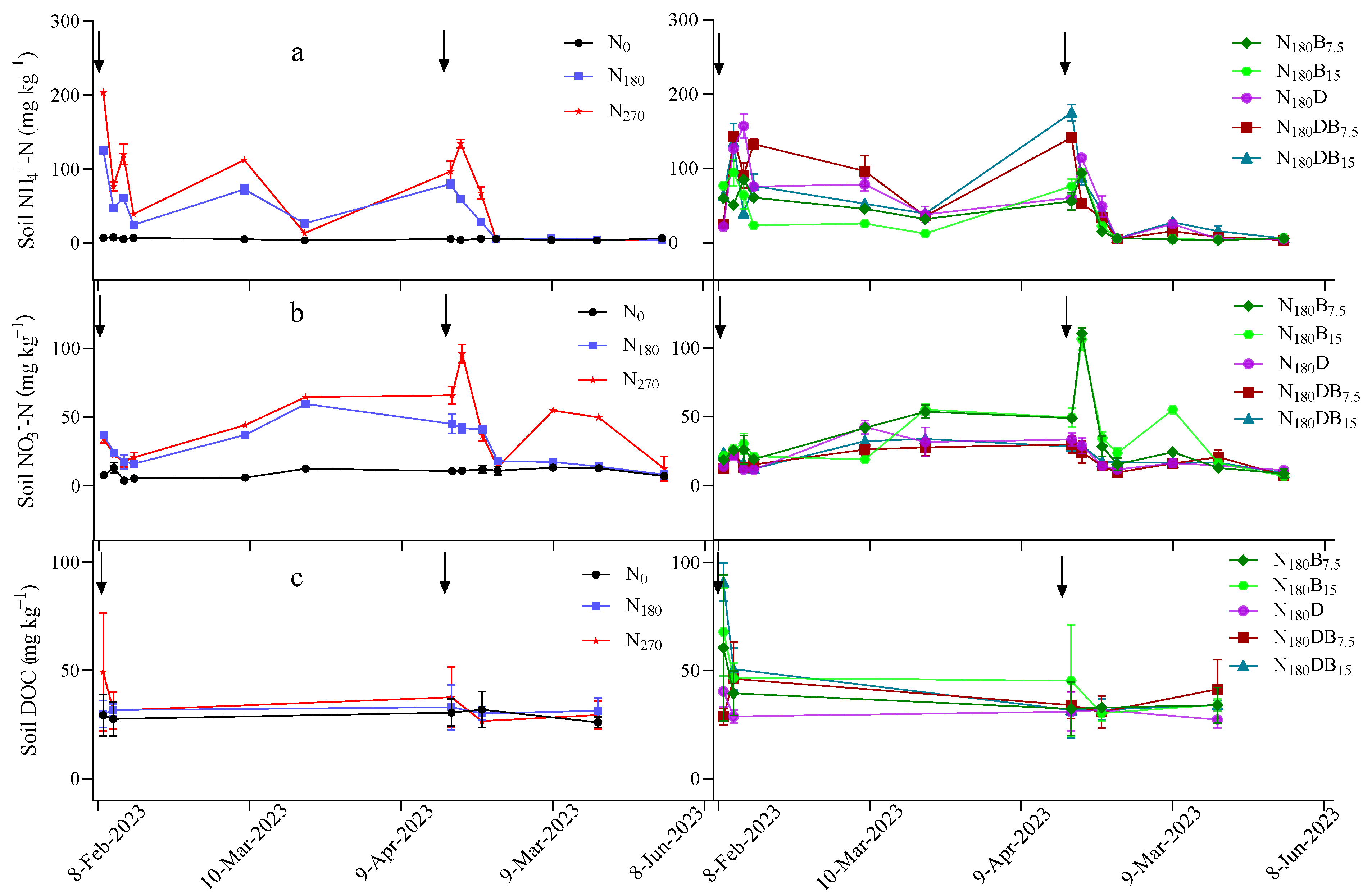

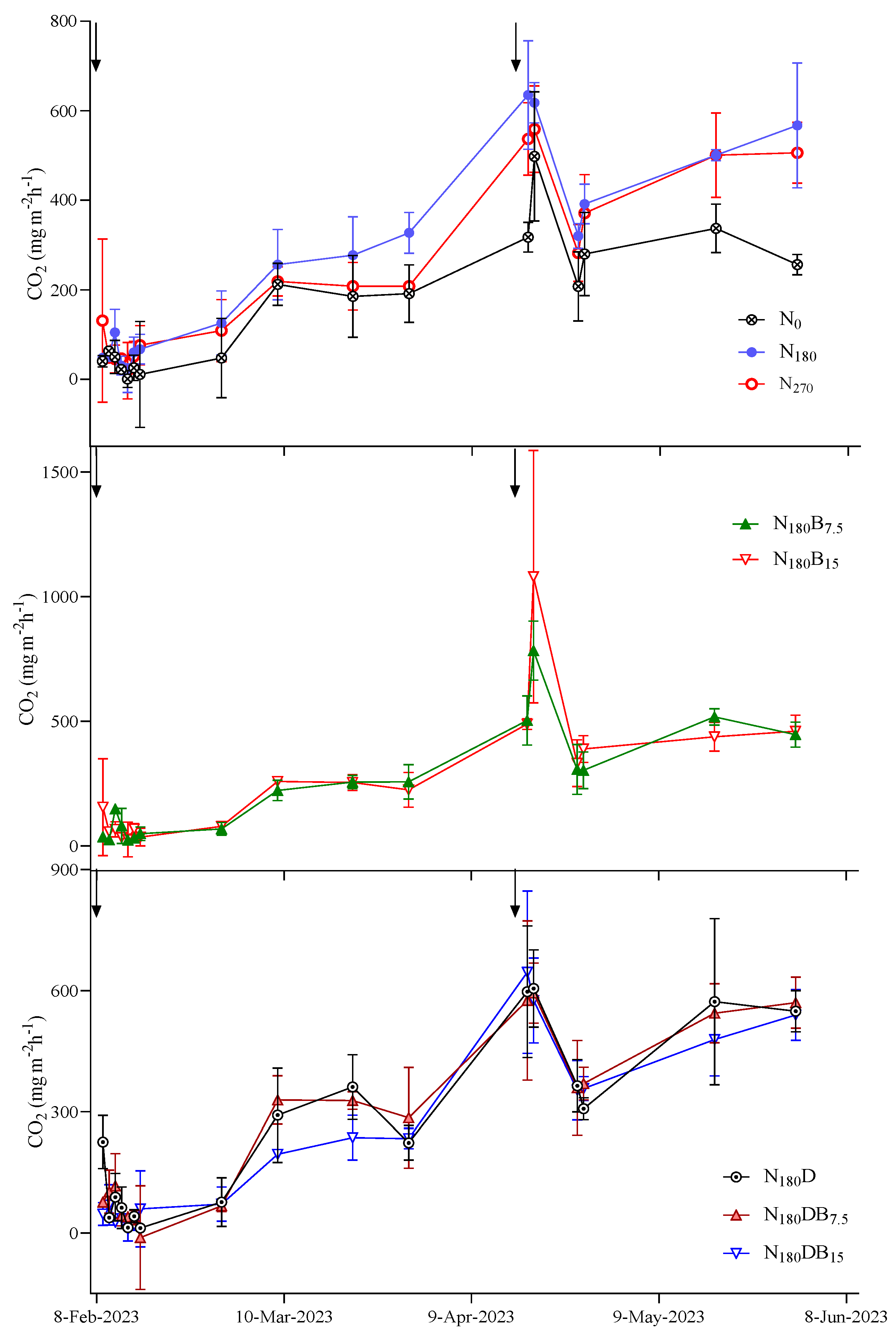
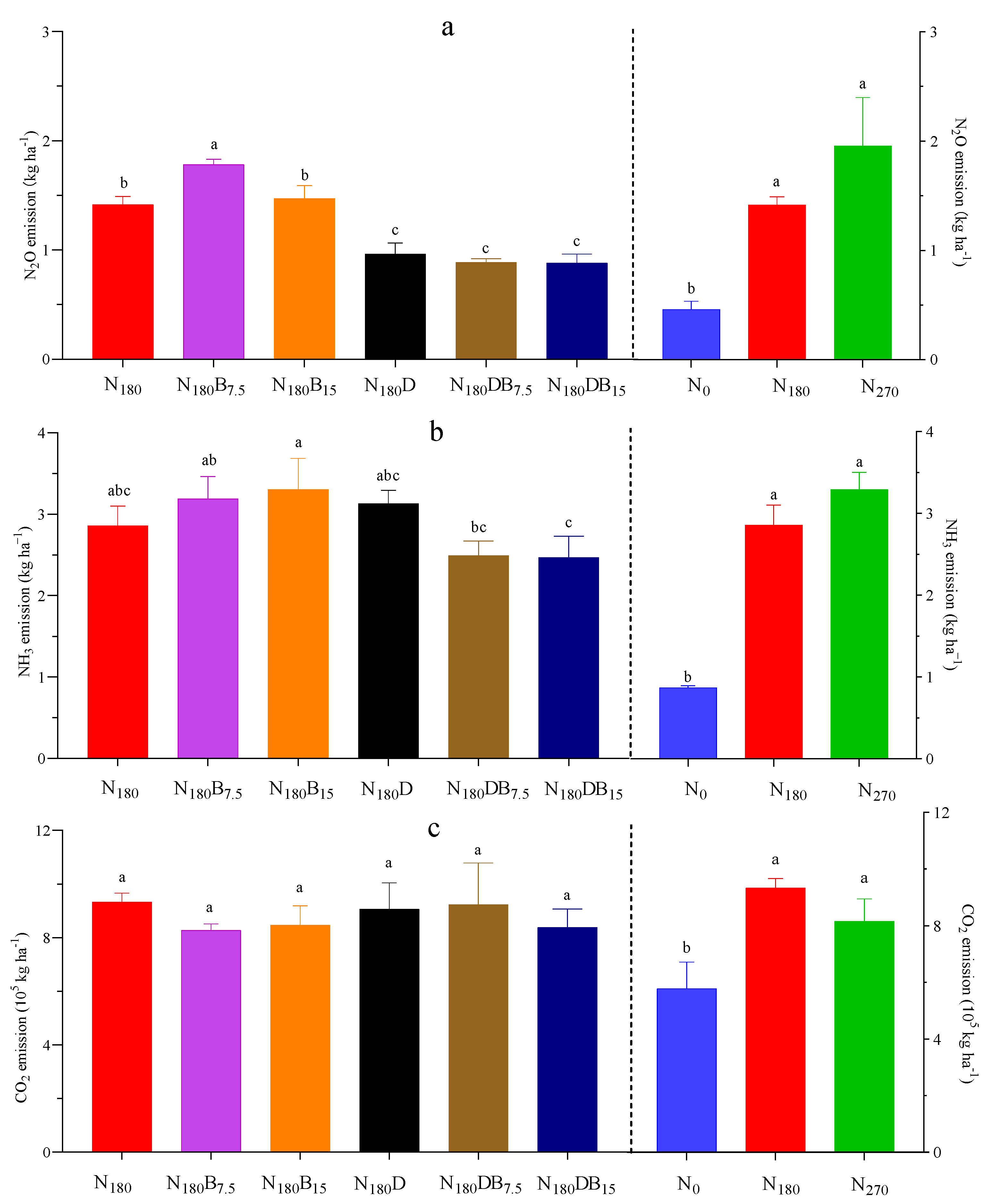
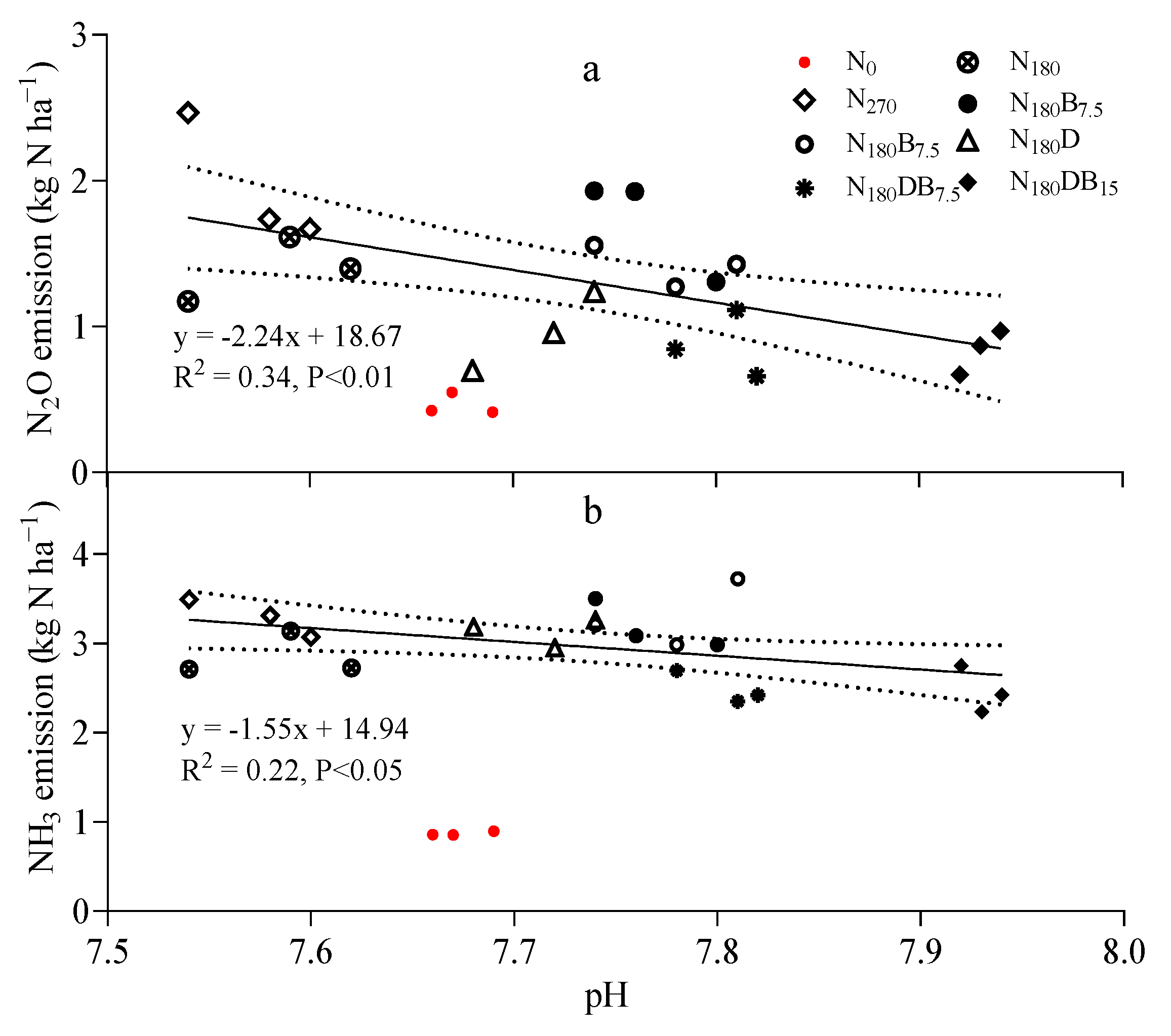

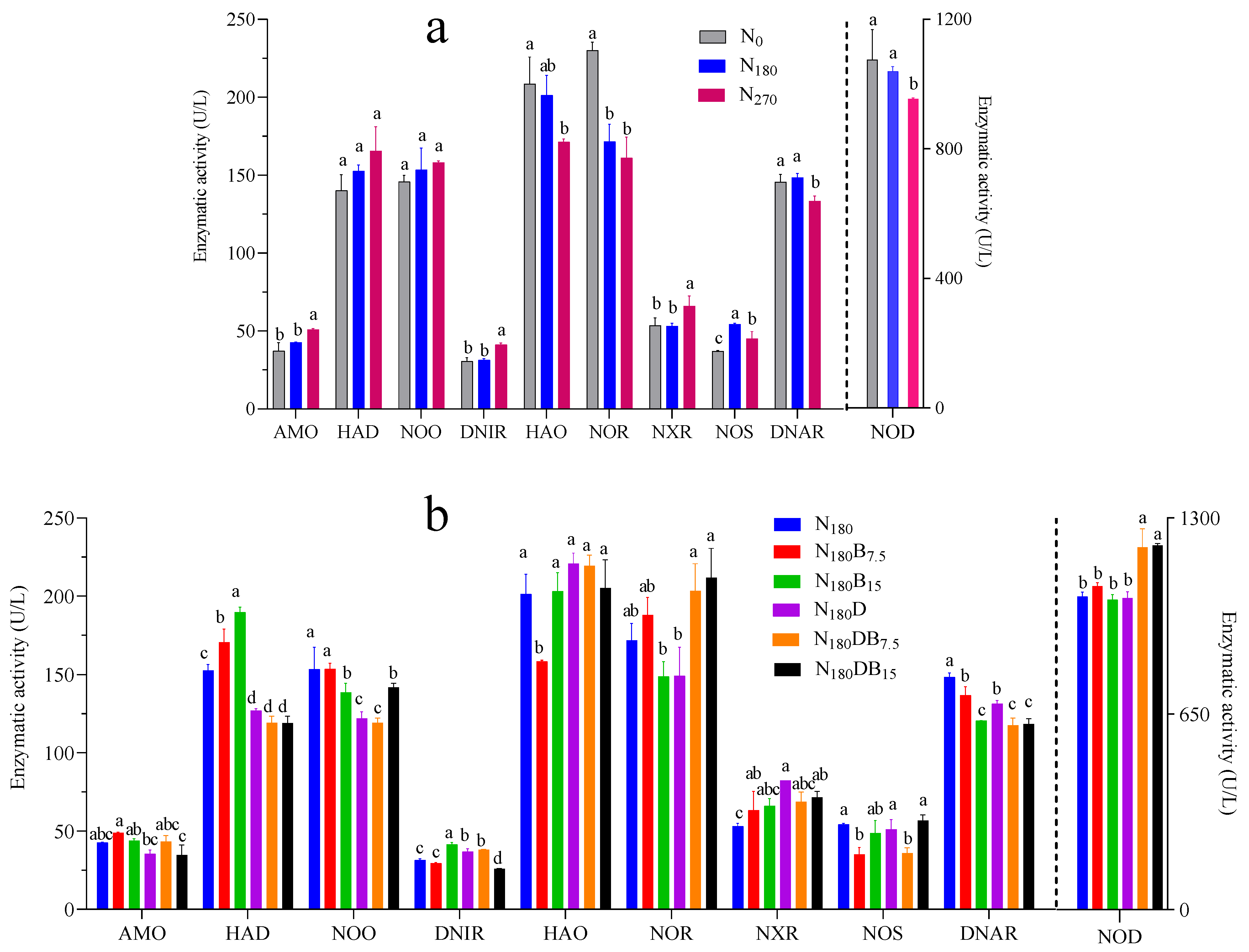
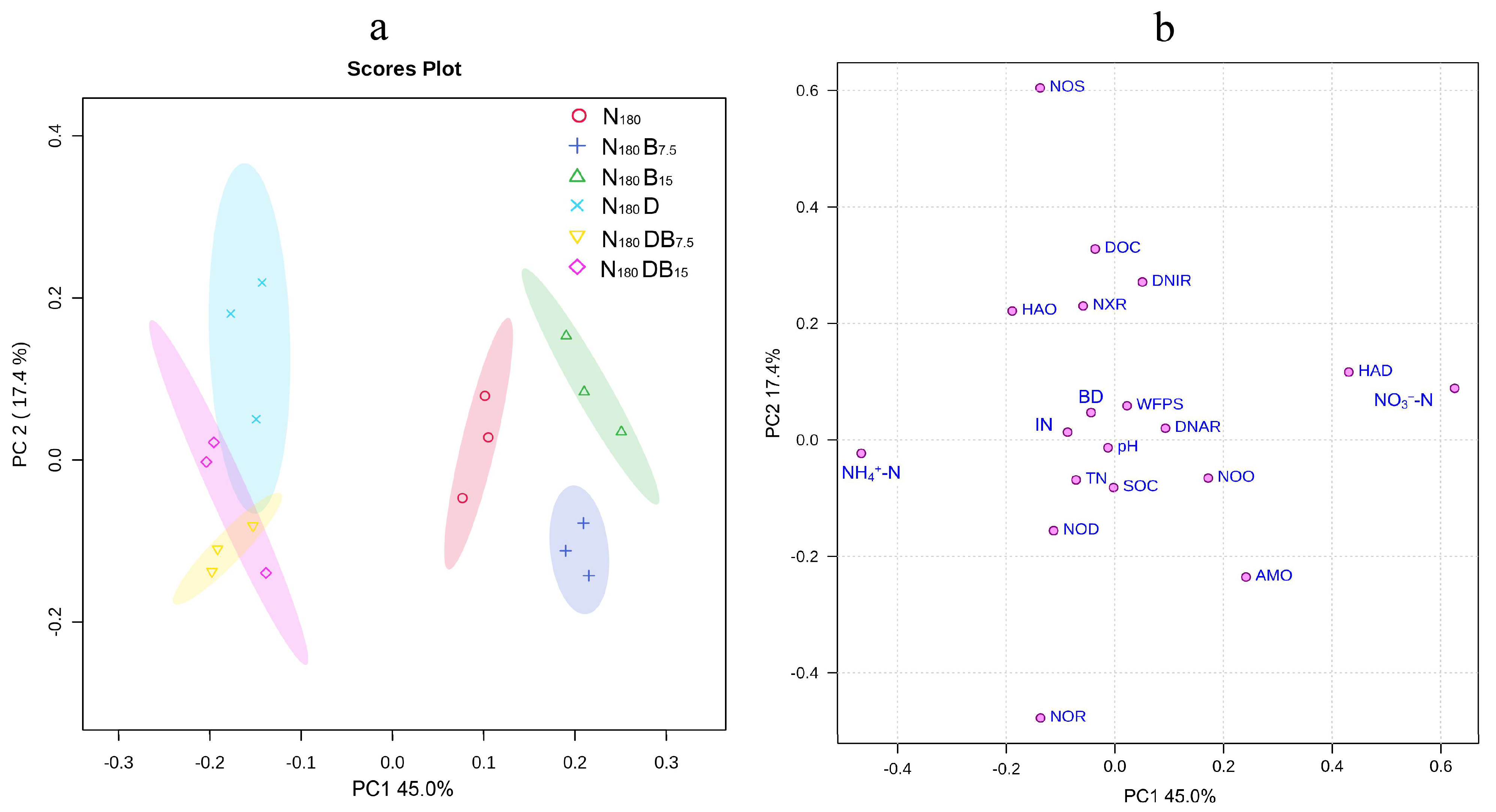

| Treatment | BD | pH | SOC (g kg−1) | TN (g kg−1) |
|---|---|---|---|---|
| N0 | 1.35 ± 0.05 a | 7.67 ± 0.02 a | 11.41 ± 0.19 b | 1.08 ± 0.13 a |
| N180 | 1.38 ± 0.04 a | 7.58 ± 0.04 b | 12.47 ± 0.08 a | 1.11 ± 0.03 a |
| N270 | 1.39 ± 0.02 a | 7.57 ± 0.03 b | 12.82 ± 0.38 a | 1.13 ± 0.01 a |
| N180 | 1.38 ± 0.04 ab | 7.58 ± 0.04 d | 12.47 ± 0.08 b | 1.11 ± 0.03 a |
| N180B7.5 | 1.28 ± 0.04 bc | 7.77 ± 0.03 b | 13.15 ± 0.78 ab | 1.18 ± 0.13 a |
| N180B15 | 1.21 ± 0.08 c | 7.78 ± 0.04 b | 13.35 ± 0.17 ab | 1.14 ± 0.13 a |
| N180D | 1.41 ± 0.05 a | 7.71 ± 0.03 c | 12.54 ± 0.28 b | 1.16 ± 0.15 a |
| N180DB7.5 | 1.30 ± 0.02 abc | 7.80 ± 0.02 b | 13.24 ± 0.54 ab | 1.28 ± 0.11 a |
| N180DB15 | 1.26 ± 0.01 c | 7.93 ± 0.01 a | 13.48 ± 0.74 a | 1.19 ± 0.10 a |
| Gas Emission | Group | NH4+-N (mg kg−1) | NO3−-N (mg kg−1) | IN (mg kg−1) | WFPS |
|---|---|---|---|---|---|
| N2O | control | 0.014 | 0.244 | 0.268 | 0.129 |
| Only N group | 0.161 | 0.336 * | 0.249 * | 0.217 | |
| Biochar group | 0.181 | 0.321 * | 0.281 ** | 0.429 ** | |
| DMPP group | 0.385 ** | 0.199 * | 0.392 ** | 0.197 * | |
| NH3 | control | 0.388 | 0.350 | −0.057 | 0.492 * |
| Only N group | 0.298 ** | 0.051 | 0. 256 | 0.480 ** | |
| Biochar group | 0.451 ** | 0.000 | 0.280 | 0.175 | |
| DMPP group | 0.646 ** | 0.361 ** | 0.652 ** | 0.371 * | |
| CO2 | control | −0.293 | 0.406 * | 0.276 | 0.094 |
| Only N group | −0.390 ** | 0.160 | −0.297 * | 0.203 | |
| Biochar group | −0.170 | 0.222 | −0.051 | 0.034 | |
| DMPP group | −0.331 ** | 0.102 | −0.294 ** | −0.236 * |
| Treatments | Grain Yield (kg ha−1) | Straw Yield (kg ha−1) | Above Ground N Uptake (kg N ha−1) | NUE (%) |
|---|---|---|---|---|
| N0 | 6295 ± 217 b | 6048 ± 778 b | 134 ± 18.3 b | - |
| N180 | 6910 ± 86 ab | 10020 ± 459 a | 229 ± 2.4 a | 52.5 ± 9.6 a |
| N270 | 7628 ± 570 a | 9838 ± 1368 a | 258 ± 36.7 a | 45.8 ± 7.0 a |
| N180 | 6910 ± 86 b | 10020 ± 459 a | 229 ± 2.4 a | 52.5 ± 9.6 a |
| N180B7.5 | 7820 ± 189 a | 9830 ± 347 a | 258 ± 10 a | 68.6 ± 4.9 a |
| N180B15 | 7399 ± 214 ab | 10956 ± 671 a | 257 ± 10.5 a | 68.3 ± 5.0 a |
| N180D | 7134 ± 118 ab | 9841 ± 457 a | 249 ± 12.7 a | 63.4 ± 15.4 a |
| N180DB7.5 | 7560 ± 233 ab | 10800 ± 167 a | 256 ± 9.3 a | 67.7 ± 13.7 a |
| N180DB15 | 7852 ± 577 a | 9911 ± 339 a | 259 ± 16.9 a | 69.4 ± 1.5 a |
| Factors | DF | EC-N2O | EC-NH3 | EC-CO2 | Grain Yield | NUE | ||||||||||
|---|---|---|---|---|---|---|---|---|---|---|---|---|---|---|---|---|
| SS | F | p | SS | F | p | SS | F | p | SS | F | p | SS | F | p | ||
| DMPP | 1 | 1.88 | 287.11 | <0.001 | 0.80 | 11.82 | <0.05 | 1.89 × 105 | 0.25 | >0.05 | 7.79 × 10−5 | 0.10 | >0.05 | 0.05 | 0.01 | >0.05 |
| Biochar | 2 | 0.09 | 7.04 | <0.05 | 0.08 | 0.55 | >0.05 | 1.84 × 106 | 1.24 | >0.05 | 0.01 | 5.94 | <0.05 | 0.01 | 0.02 | >0.05 |
| DMPP × Biochar | 2 | 0.15 | 11.68 | <0.05 | 1.10 | 8.10 | <0.05 | 1.32 × 106 | 0.89 | >0.05 | 0.00 | 2.49 | >0.05 | 0.01 | 0.01 | >0.05 |
| Model | 5 | 2.13 | 64.91 | <0.001 | 1.97 | 5.83 | <0.05 | 3.35 × 106 | 0.90 | >0.05 | 0.01 | 3.39 | <0.05 | 0.06 | 0.01 | >0.05 |
| Error | 12 | 0.08 | 0.81 | 8.93 × 106 | 0.01 | 0.114 | 0.01 | |||||||||
Disclaimer/Publisher’s Note: The statements, opinions and data contained in all publications are solely those of the individual author(s) and contributor(s) and not of MDPI and/or the editor(s). MDPI and/or the editor(s) disclaim responsibility for any injury to people or property resulting from any ideas, methods, instructions or products referred to in the content. |
© 2024 by the authors. Licensee MDPI, Basel, Switzerland. This article is an open access article distributed under the terms and conditions of the Creative Commons Attribution (CC BY) license (https://creativecommons.org/licenses/by/4.0/).
Share and Cite
Wu, H.; Wang, D.; Zhang, D.; Rao, W.; Yuan, Q.; Shen, X.; Ma, G.; Jie, X.; Liu, S. Responses of N2O, CO2, and NH3 Emissions to Biochar and Nitrification Inhibitors Under a Delayed Nitrogen Application Regime. Agriculture 2024, 14, 1986. https://doi.org/10.3390/agriculture14111986
Wu H, Wang D, Zhang D, Rao W, Yuan Q, Shen X, Ma G, Jie X, Liu S. Responses of N2O, CO2, and NH3 Emissions to Biochar and Nitrification Inhibitors Under a Delayed Nitrogen Application Regime. Agriculture. 2024; 14(11):1986. https://doi.org/10.3390/agriculture14111986
Chicago/Turabian StyleWu, Haizhong, Daichang Wang, Dengxiao Zhang, Wei Rao, Qingsong Yuan, Xiaobo Shen, Guozhen Ma, Xiaolei Jie, and Shiliang Liu. 2024. "Responses of N2O, CO2, and NH3 Emissions to Biochar and Nitrification Inhibitors Under a Delayed Nitrogen Application Regime" Agriculture 14, no. 11: 1986. https://doi.org/10.3390/agriculture14111986
APA StyleWu, H., Wang, D., Zhang, D., Rao, W., Yuan, Q., Shen, X., Ma, G., Jie, X., & Liu, S. (2024). Responses of N2O, CO2, and NH3 Emissions to Biochar and Nitrification Inhibitors Under a Delayed Nitrogen Application Regime. Agriculture, 14(11), 1986. https://doi.org/10.3390/agriculture14111986







